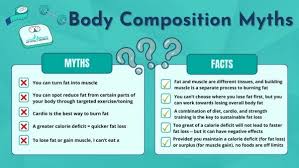The idea of targeting fat loss in specific areas of the body, often referred to as “spot reduction,” is a popular concept in the fitness world. However, it’s a topic clouded with myths, misconceptions, and a lack of scientific understanding. This article aims to dissect the myths and facts about targeted fat loss, providing evidence-based insights to help you make informed fitness decisions.
What Is Targeted Fat Loss?
Targeted fat loss, or spot reduction, is the notion that you can lose fat in specific areas of your body by performing exercises that target those areas. For example, doing hundreds of crunches to lose belly fat or tricep dips to get rid of arm fat. While the idea sounds appealing, the reality is much more complex.
The Science of Fat Loss
To understand why targeted fat loss is a myth, it’s essential to grasp how the body loses fat:
1. Fat Is Stored as Energy
Fat in the body is stored in adipose tissue as triglycerides. When you’re in a caloric deficit (burning more calories than you consume), your body breaks down triglycerides into glycerol and free fatty acids to use as energy. These are transported through the bloodstream to be burned as fuel.
2. Fat Loss Occurs Systemically
Fat is not burned directly from the muscles being exercised. Instead, fat loss occurs systemically, meaning the body decides where to draw fat from based on genetics, hormones, and overall energy needs. This is why you might lose fat from your face before your stomach, or vice versa.
3. Exercise Targets Muscles, Not Fat
While exercises like crunches or leg lifts can strengthen the muscles in specific areas, they do not directly affect the fat covering those muscles. Strengthening underlying muscles can improve muscle tone, but the overlying fat must be reduced through a combination of diet, cardio, and overall strength training.
Common Myths About Targeted Fat Loss
Myth 1: Ab Workouts Burn Belly Fat
Performing ab exercises can strengthen your core but won’t specifically burn fat from your stomach. A study published in the Journal of Strength and Conditioning Research found that six weeks of abdominal exercises had no significant effect on abdominal fat loss.
Myth 2: Spot Reduction Is Possible with Technology or Gadgets
Products like waist trainers, vibrating belts, or topical creams claim to help reduce fat in targeted areas. However, there’s little to no scientific evidence supporting these claims. These products often create temporary effects, such as water loss, which is not the same as fat loss.
Myth 3: High-Repetition Workouts for Fat Loss
While high-repetition, low-weight workouts can increase endurance, they do not necessarily target fat in specific areas. Fat loss requires a caloric deficit and overall fitness regimen.
How to Effectively Lose Fat
If targeted fat loss isn’t possible, what’s the best way to lose fat? Here are evidence-based strategies:
1. Create a Caloric Deficit
A consistent caloric deficit is the cornerstone of fat loss. This can be achieved through a combination of diet and exercise:
- Diet: Focus on nutrient-dense foods, high protein intake, and balanced macronutrients.
- Exercise: Incorporate a mix of cardio, strength training, and high-intensity interval training (HIIT).
2. Build Muscle Through Strength Training
Strength training increases muscle mass, which boosts your resting metabolic rate (RMR). A higher RMR means your body burns more calories, even at rest, aiding in overall fat loss.
3. Incorporate Cardio
Cardiovascular exercises like running, cycling, or swimming help burn calories and improve heart health. Combine steady-state cardio with HIIT for optimal fat-burning results.
4. Manage Stress and Sleep
High stress levels and poor sleep can increase cortisol, a hormone linked to fat storage. Prioritize stress management and aim for 7-9 hours of quality sleep per night.
Benefits of a Holistic Approach
By focusing on overall fitness and fat loss rather than targeted areas, you can achieve sustainable results:
- Balanced Physique: A combination of strength training and cardio helps create a balanced, well-toned physique.
- Improved Health: A holistic approach addresses cardiovascular health, mental well-being, and physical strength.
- Sustainable Results: Long-term habits lead to consistent fat loss and better overall health.
FAQs About Targeted Fat Loss
1. Can I Target Fat Loss in My Belly or Arms?
No, fat loss cannot be targeted to specific areas. It occurs systemically based on genetics, hormones, and overall energy expenditure.
2. Why Do Certain Areas of My Body Hold More Fat?
Your body’s fat distribution is largely determined by genetics and hormones. For example, women tend to store fat in their hips and thighs, while men are more likely to store fat in their abdomen.
3. Are There Exercises That Help with Overall Fat Loss?
Yes, compound exercises like squats, deadlifts, and push-ups engage multiple muscle groups, burn more calories, and contribute to overall fat loss.
4. Do Supplements Help with Fat Loss?
Some supplements, like caffeine or green tea extract, can boost metabolism slightly. However, they are not a substitute for a proper diet and exercise routine.
5. How Long Does It Take to See Results?
Fat loss timelines vary based on factors like starting point, consistency, and genetics. On average, a safe and sustainable rate is 1-2 pounds of fat loss per week.
Targeted fat loss is a persistent myth in the fitness industry. While it’s not possible to spot-reduce fat, a holistic approach involving a caloric deficit, strength training, and cardio can help you achieve your fitness goals. Focus on overall health and sustainable habits, and you’ll not only lose fat but also improve your strength, endurance, and well-being.
Remember, fitness is a journey, not a destination. Equip yourself with the right knowledge and enjoy the process of becoming the healthiest version of yourself.
Debunk the myths of targeted fat loss! Learn the facts about spot reduction, effective fat loss strategies, and how to achieve sustainable fitness goals.